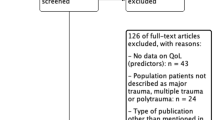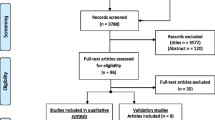Abstract
Background:
Major trauma is the leading cause of mortality and morbidity in children of developed countries. Little research has been done about the health-related quality of life (HRQL) in these children. The aim of the current research is to describe the HRQL of children in the long term after major trauma and to compare it with healthy peers.
Methods:
A prospective cohort study of severely injured children (ISS ≥ 16, age < 16 years) who survived the trauma and were admitted to the emergency department of a Dutch level 1 trauma center in 1999 and 2000 (n = 40) was conducted. Between 6 and 8 years after trauma (mean 7.3, SD 0.7 years), outcome was assessed by the Pediatric Quality of Life Inventory (PedsQL 4.0), the EuroQol 5D (EQ-5D), and the EuroQol Visual Analogue Scale (EQ-VAS).
Results:
The mean age at the time of the accident was 8.9 years (SD 4.6 years), the mean ISS was 24.9 (SD 11.1), and 25 (63%) cases were male; 28 out of 40 patients were followed up. The mean score on the PedsQL was 81.2 and this did not differ significantly from the norm value. On the EQ-5D, more health problems were reported than in a healthy reference population. The mean EQ-VAS score was 79.4 and was significantly lower than in healthy peers. The lowest scores on the PedsQL and the EQ-VAS were seen in teenagers and in respondents with spinal cord and/or severe cerebral injury.
Conclusion:
The results on HRQL in children in the long term after major trauma are inconclusive. Special attention should be given to teenagers with spinal cord or severe cerebral injury who reported the lowest HRQL.
Similar content being viewed by others
Abbreviations
- CHQ::
-
Child Health Questionnaire
- EQ- 5D:
-
EuroQol 5D
- EQ-VAS::
-
EuroQol Visual Analogue Scale
- HRQL::
-
Health-related quality of life
- ISS::
-
Injury Severity Score
- PedsQL::
-
Pediatric Quality of Life Inventory
- SPSS::
-
Statistical Package for the Social Sciences
- UMCU::
-
University Medical Center Utrecht
References
Baker SP, O’Neill B, Haddon W Jr, Long WB. The injury severity score: a method for describing patients with multiple injuries and evaluating emergency care. J Trauma 1974;14:187–96.
Suominen P, Kivioja A, Ohman J, Korpela R, Rintala R, Olkkola KT. Severe and fatal childhood trauma. Injury 1998;29:425–30.
van der Sluis CK, Kingma J, Eisma WH, ten Duis HJ. Pediatric polytrauma: short-term and long-term outcomes. J Trauma 1997;43:501–6.
Vademecum of Health Statistics of the Netherlands: 2003. Statistics Netherlands, Ministry of Health, Welfare and Sports, Voorburg/Heerlen, The Netherlands. 2004.
Roach JO. Injuries kill over 20,000 children a year in developed countries. BMJ 2001;322:317.
Polinder S, Meerding WJ, Toet H, Mulder S, Essink-Bot ML, van Beeck EF. Prevalence and prognostic factors of disability after childhood injury. Pediatrics 2005;116:810–7.
Schalamon J, v Bismarck S, Schober PH, Höllwarth ME. Multiple trauma in pediatric patients. Pediatr Surg Int 2003;19:417–23.
Evans SA, Airey MC, Chell SM, Connelly JB, Rigby AS, Tennant A. Disability in young adults following major trauma: 5 year follow up of survivors. BMC Public Health 2003;3:8.
Letts M, Davidson D, Lapner P. Multiple trauma in children: predicting outcome and long-termresults. Can J Surg 2002;45:126–31.
Hu X, Wesson DE, Logsetty S, Spence LJ. Functional limitations and recovery in children with severe trauma: a one-year followup. J Trauma 1994;37:209–13.
Wesson DE, Williams JI, Spence LJ, Filler RM, Armstrong PF, Pearl RH. Functional outcome in pediatric trauma. J Trauma 1989;29:589–92.
World Health Organization (WHO). International Classification of Functioning, Disability and Health: ICF. Geneva, Switzerland: World Health Organization, 2001.
Janssens L, Gorter JW, Ketelaar M, Kramer WL, Holtslag HR. Health-related quality-of-life measures for long-term follow-up in children after major trauma. Qual Life Res 2008;17:701–13.
McCarthy ML. Measuring children’s health-related quality of life after trauma. J Trauma 2007;63:S122–9.
Willis CD, Gabbe BJ, Butt W, Cameron PA. Assessing outcomes in paediatric trauma populations. Injury 2006 37:1185–96.
van Beeck EF, Larsen CF, Lyons RA, Meerding WJ, Mulder S, Essink-Bot ML. Guidelines for the conduction of follow-up studies measuring injury-related disability. J Trauma 2007;62:534–50.
Holbrook TL, Hoyt DB, Coimbra R, Potenza B, Sise MJ, Sack DI, Anderson JP. Trauma in adolescents causes long-term marked deficits in quality of life: adolescent children do not recover preinjury quality of life or function up to two years postinjury compared to national norms. J Trauma 2007;62:577–83.
Winthrop AL, Brasel KJ, Stahovic L, Paulson J, Schneeberger B, Kuhn EM. Quality of life and functional outcome after pediatric trauma. J Trauma 2005;58:468–474.
Davey TM, Aitken LM, Kassulke D, Bellamy N, Ambrose J, Gee T, Clark M. Long-term outcomes of seriously injured children: a study using the Child Health Questionnaire. J Paediatr Child Health 2005;41:278–83.
Sturms LM, Sluis van der CK, Stewart RE, Groothoff JW, Duis ten HJ, Eisma WH. A prospective study on paediatric traffic injuries: health-related quality of life and post-traumatic stress. Clin Rehabil 2005;19:312–22.
Sturms LM, van der Sluis CK, Groothoff JW, ten Duis HJ, Eisma WH. Young traffic victims’ long-term health-related quality of life: child self-reports and parental reports. Arch Phys Med Rehabil 2003;84:431–6.
Sturms LM, van der Sluis CK, Groothoff JW, Eisma WH, ten Duis HJ. The health-related quality of life of pediatric traffic victims. J Trauma 2002;52:88–94.
McCarthy ML, MacKenzie EJ, Durbin DR, Aitken ME, Jaffe KM, Paidas CN, Slomine BS, Dorsch AM, Berk RA, Christensen JR, Ding R; CHAT Study Group. The Pediatric Quality of Life Inventory: an evaluation of its reliability and validity for children with traumatic brain injury. Arch Phys Med Rehabil 2005;86:1901–8.
Varni JW, Limbers CA, Burwinkle TM. How young can children reliably and validly self-report their health-related quality of life? An analysis of 8,591 children across age subgroups with the PedsQL 4.0 Generic Core Scales. Health Qual Life Outcomes 2007;5:1.
Varni JW, Limbers CA, Burwinkle TM. Parent proxy-report of their children’s health-related quality of life: an analysis of 13,878 parents’ reliability and validity across age subgroups using the PedsQL 4.0 Generic Core Scales. Health Qual Life Outcomes 2007;5:2.
Cremeens J, Eiser C, Blades M. Factors influencing agreement between child self-report and parent proxy-reports on the Pediatric Quality of Life Inventory 4.0 (PedsQL) generic core scales. Health Qual Life Outcomes 2006;4:58.
Varni JW, Burwinkle TM, Seid M. The PedsQL 4.0 as a school population health measure: feasibility, reliability, and validity. Qual Life Res 2006;15:203–15.
Bastiaansen D, Koot HM, Bongers IL, Varni JW, Verhulst FC. Measuring quality of life in children referred for psychiatric problems: psychometric properties of the PedsQL 40 generic core scales. Qual Life Res 2004;13:489–95.
Varni JW, Seid M, Kurtin PS. PedsQL 4.0: reliability and validity of the Pediatric Quality of Life Inventory version 4.0 generic core scales in healthy and patient populations. Med Care 2001;39:800–12.
Brooks R. EuroQol: the current state of play. Health Policy 1996;37:53–72.
Sach TH, Barton GR. Interpreting parental proxy reports of (health-related) quality of life for children with unilateral cochlear implants. Int J Pediatr Otorhinolaryngol 2007;71:435–45.
Matza LS, Secnik K, Mannix S, Sallee FR. Parent-proxy EQ-5D ratings of children with attention-deficit hyperactivity disorder in the US and the UK. Pharmacoeconomics 2005;23:777–90.
Vitale MG, Levy DE, Johnson MG, Gelijns AC, Moskowitz AJ, Roye BP, Verdisco L, Roye DP Jr. Assessment of quality of life in adolescent patients with orthopaedic problems: are adult measures appropriate? J Pediatr Orthop 2001;21:622–8.
Stolk EA, Busschbach JJV, Vogels T. Performance of the EuroQol in children with imperforate anus. Qual Life Res 2000;9:29–38.
Essink-Bot ML, Stouthard ME, Bonsel GJ. Generalizability of valuations on health states collected with the EuroQolc-questionnaire. Health Econ 1993;2:237–46.
Author information
Authors and Affiliations
Corresponding author
Rights and permissions
About this article
Cite this article
Janssens, L., Gorter, J.W., Ketelaar, M. et al. Long-Term Health-Related Quality of Life in Major Pediatric Trauma: A Pilot Study. Eur J Trauma Emerg Surg 35, 371–377 (2009). https://doi.org/10.1007/s00068-009-8217-y
Received:
Accepted:
Published:
Issue Date:
DOI: https://doi.org/10.1007/s00068-009-8217-y




